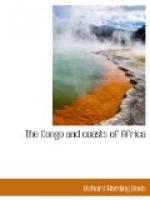Although we were travelling by boat, we spent as much time on land as on the water. Because the Deliverance burnt wood and, like an invading army, “lived on the country,” she was always stopping to lay in a supply. That gave Anfossi and myself a chance to visit the native villages or to hunt in the forest.
To feed her steamers the State has established along the river-bank posts for wood, and in theory at these places there always is a sufficient supply of wood to carry a steamer to the next post. But our experience was either that another steamer had just taken all the wood or that the boys had decided to work no more and had hidden themselves in the bush. The State posts were “clearings,” less than one hundred yards square, cut out of the jungle. Sometimes only black men were in charge, but as a rule the chef de poste was a lonely, fever-ridden white, whose only interest in our arrival was his hope that we might spare him quinine. I think we gave away as many grains of quinine as we received logs of wood. Empty-handed we would turn from the wood post and steam a mile or so farther up the river, where we would run into a bank, and a boy with a steel hawser would leap overboard and tie up the boat to the roots of a tree. Then all the boys would disappear into the jungle and attack the primeval forest. Each was supplied with a machete and was expected to furnish a bras of wood. A bras is a number of sticks about as long and as thick as your arm, placed in a pile about three feet high and about three feet wide. To fix this measure the head boy drove poles into the bank three feet apart, and from pole to pole at the same distance from the ground stretched a strip of bark. When each boy had filled one of these openings all the wood was carried on board, and we would unhitch the Deliverance, and she would proceed to burn up the fuel we had just collected. It took the twenty boys about four hours to cut the wood, and the Deliverance the same amount of time to burn it. It was distinctly a hand-to-mouth existence. As I have pointed out, when it is too dark to see the currents, the Congo captains never attempt to travel. So each night at sunset Captain Jensen ran into the bank, and as soon as the plank was out all the black passengers and the crew passed down it and spent the night on shore. In five minutes the women would have the fires lighted and the men would be cutting grass for bedding and running up little shelters of palm boughs and hanging up linen strips that were both tents and mosquito nets.
[Illustration: The Native Wife of a Chef de Poste.]




